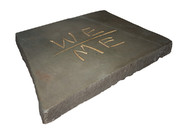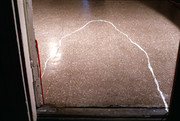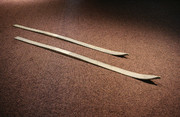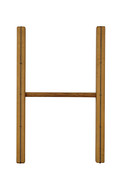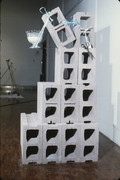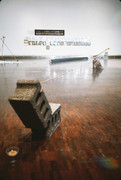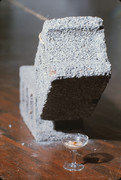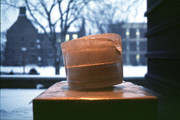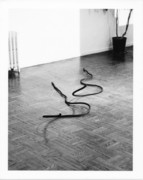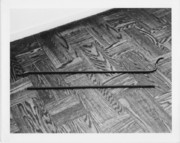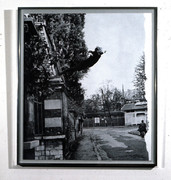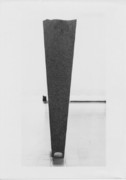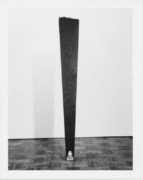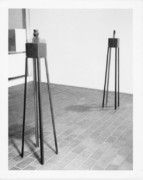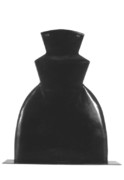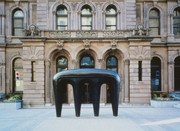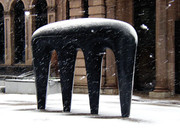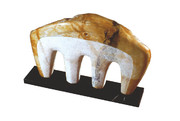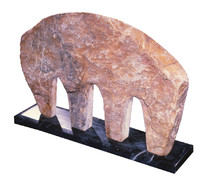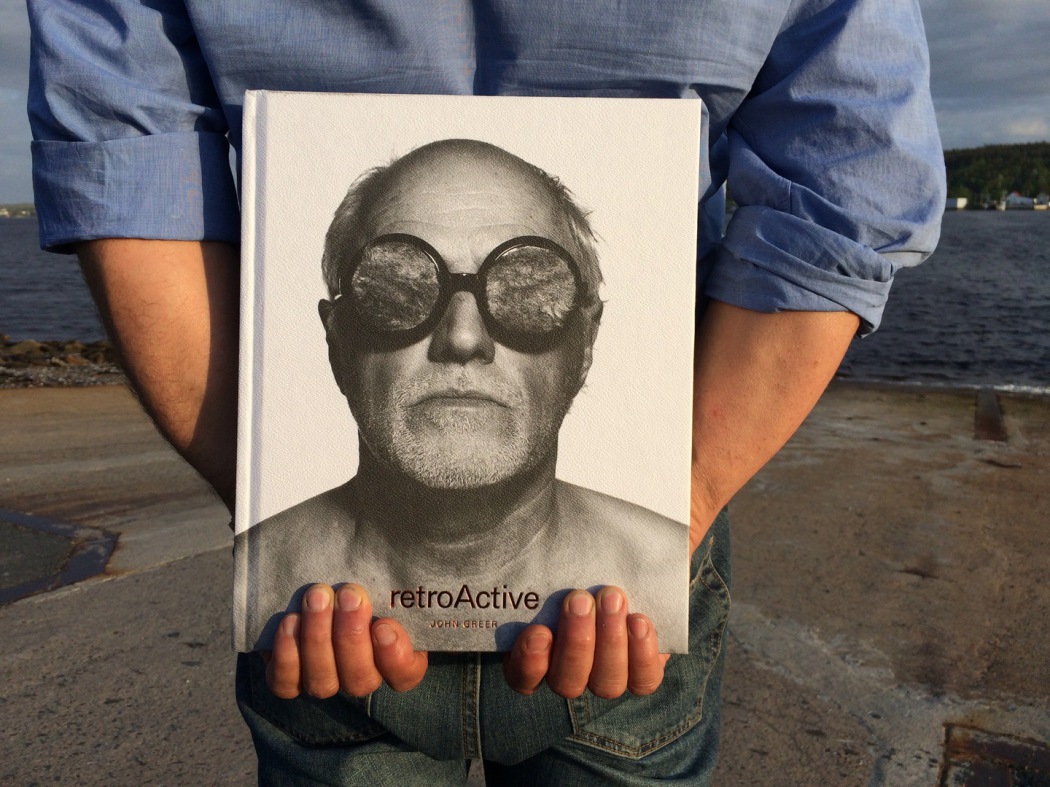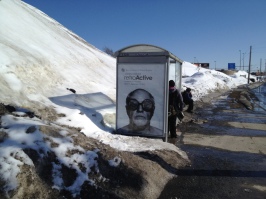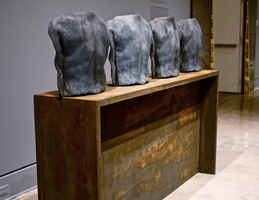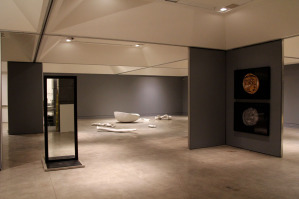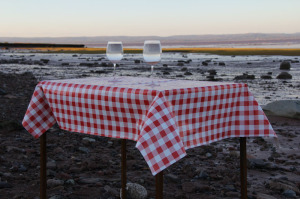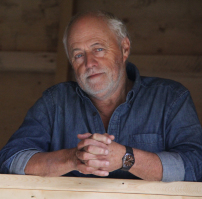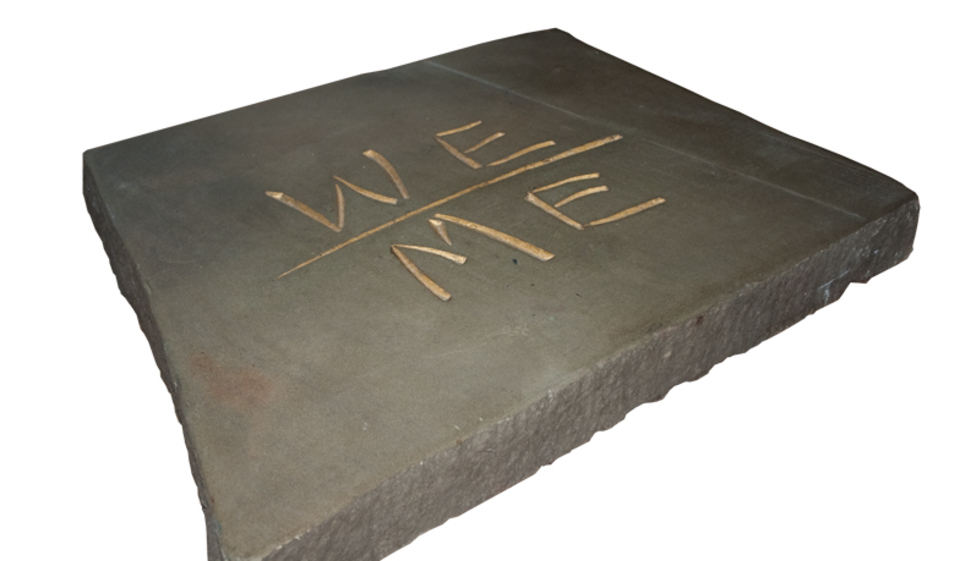
WElcoME
Everything goes in twos; or the sharks will bite.
Lau (Fijian) saying
"The unaltered WE/ME stone is a particular old favorite and has its genesis in an endeavor with a door mat.
Greer had been arranging certain electrical components in combination with a standard welcome mat. The general intention was to have the participant step onto the mat and pressure-activate a switch that would operate circuitry producing a clap of thunder and a bolt of lightning. This experimental encounter in many ways played off the Greek myths dealing with jests of the gods. People were constantly being reminded that the deities could assume human forms and by so doing entice mortals into compromising situations that were intended to encourage humility and sponsor sublimation.
Greer, while engaged in experimentation, shorted out the electrical apparatus and all but electrocuted himself. When the incident was essentially over, he conducted a rather frantic bodily inventory. Realizing he was still alive, he also noticed that his foot was blocking out the exact middle section of the we/lco/me on the doormat, exposing only we me.
The gods indeed were still on duty and a rerouting of intention had occurred. Greer eventually proceeded literally to write the message in stone and establish the mirrored image condition of each respective word. Namely, that the collective exists vis-à-vis the subjective, as one simultaneous act." (Dennis Gill)47
With the “WE/ME stone”, 1983 Greer visualized a reflection on the social act. He was and still is interested to transcend the "banal" while focusing more on daily life than on "spirit" as an issue. For him the changes in our world occur through experience - and that implies that people stop relying on verbal advice, but reconsider reality through personal experience. In contrast to information, which is, according to the artist, a status quo, he is provoking with his work to consider experience as basis for all changes in the world, for the understanding in the world. This becomes evident in pieces like "ghost of a chance" 1979, a ghost-line marking the entrance of a gallery room which causes us to be alert and watch our step and wonder. Or "cross country" 1980 a pair of iron cast skies without binding which are weighing down our step - once we step on them - and enlighten our "stepping out" and "moving on" in life. The "Ladder of Commitment" 1976, a wooden ladder with just one rung, hung on the wall, is pointing out to the quintessence that, if you are committed, you are there: you do not need more than one rung, but this one is demanding an activity of balance.
Already in the early seventies Greer starts to visualize human issues from a humanistic stand. "Monument for the destruction of a minority culture" 1972 is a direct way of involving the viewer's judgmental and interactive interests. Greer added a pair of scissors to a work, which had the potential for a simple, offensive act of destruction through a thin cord-attachment - it had to be cut in order to cause a brick-stone to smash a glass of yoghurt. "Two cultures in one blow" 1972 worked on the same level - exchanging the scissors for an axe and doubling the event, making a case become a condition. Significant is the tautological use of material: brick stones are human constructions, yoghurt cultures are living cultures, the axe and the pair of scissors are tools. This imagery stands for more complex interconnections in human encounter, but it is working on an every-day level. The work "Icolated Culture" 1979, which is to be seen in succession of the early yoghurt works, stand for human conditions and social issues. These are taking place through the viewer's connotations, in his mind.
In connection with these works, you can truly see the proximity to Marcel Duchamp. Greer has a very own way of looking at Duchamp's work. For him, Duchamp is visualizing the artist as a kind of conduit through his sensibility - is visualizing analytical ideas in our natural world. "That is about having faith in the natural world and having an understanding of the human construct, and tying the two together."(John Greer)48
Greer undertook his own research into the construct of humanity with three works that worked by literally repulsing the viewer instead of attracting him in the usual way: "Subjective position 1" (Reflecting upon itself), "Subjective position 2" (Confronting itself), "Subjective position 3" (beside itself) from 1982, consisted of iron bars that were bent in snakelike curves and installed on beds of salt. The metal bars were connected to a source of electricity, so that they were heated and would burn anyone who dared touching them. The forms were chosen in the symbolic reference of a line as an analytical construct for movement.
This field of tactile experience is using a symbolic language, thus relating body and logic, alertness and interest in experience. The title directs the approach to the language of symbols, which connect our real nature to the analytical construct. This reference to the analytical line as sign for movement and succession is leading towards an investigation of the form as an object; the snakelike shape suggesting movement, a state of becoming alive, "being": "Living Rebar" 1984 and "Urban Snakes" 1984 are other examples for that.
Greer started to use these forms in a couple of shows as silent gallery goers, accompanying the viewer between the art objects. Of importance for Greer was the foreignness of the objects in reference to snakes, and the resulting alertness of the spectator. Greer was concerned to get the viewer engaged - to sensitize him enough in order to experience a change in thought and consciously encounter a work, and thus initiating a change in a person's life.
This impact on life itself made Greer getting interested in Yves Klein's work; his homage to Klein, "Y.D.KLEIN" 1974 is connected to the shared faith in art. For Greer the most important and outstanding aspect was Klein's understanding of "where ideas come from" and of what Greer calls "procreation" in opposition to "creation". The inclusion of life and time in the work (thinking of works like the sponge paintings, the living brushes) and the exposition of the void as an infinite potential, show a sensibility for the understanding of life through art, which was most convincing to John Greer. "Only to state or to write: I have overcome the problematic of art, that is not enough. You really have to have it done. I did it. For me, painting is not any more in connection to our current eye: it is relating to the only thing in ourselves, that we do not own: to our life." (Yves Klein)49
Greer himself turned towards an appreciation of the work of art as a "higher", and most profound encounter, but not trying to integrate the artistic act itself into life. He is positioning his work as objects among us, but always in the sense of made things: objects of art, manifestations of intelligence. This classification - only - ensures the realm of a profound encounter, which is reaching one level with the life of the viewer. If one dares to see Yves Klein's living brushes as "ready-mades" in the Duchampian sense, than Greer's ready-mades in those years turned out to be the symbols - the symbolic meaning that he started to apply to material, shape and colour of his objects.
In 1978 John Greer traveled to Germany in order to see some original pieces by Yves Klein. During the same passage he went to Scotland, where he got interested in the ancient culture of the Picts. Reminiscent of this culture are hundreds of stone markers that are still to be found throughout the country, placed at specific locations in the landscape. These stones are covered with incised symbols, which reveal the use of a highly organized system of symbolism. Greer found symbols that he was already using in his work, like the mirror, the axe, the serpent, and he was inspired to investigate symbols that were recognizable in their form, but disconnected from their original meaning. "Just over a thousand years ago Pictish society disappeared as a distinctive entity but they left behind, as silent witness to their existence, a remarkable series of sculptured stones that is without parallel in Europe. The prime purpose of these standing stones was to display symbolic messages about their society but these, once public, statements are now most secret. Perhaps the messages were so obvious, trivial and commonplace that it did not seem at all noteworthy to contemporary Christian commentators. However to us they are a puzzle that more than a century of devoted scholarship has failed to explain."(Anthony Jackson)50
In the early eighties Greer began to use symbolism in a more complex way than before. Symbols are for him signifiers for manifested intelligence, to be seen as containers of a specific memory, and therefore as expressions of human intellect. In our time they are still loaded with various associations. Now translated into a sculptural symbolism they are charging actual space for a current encounter.
Greer made several works that used symbols together with objects, but were still talking about the process of releasing memory into the world - of a re-disposition of energy that is manifested through an intellectual device - the symbol. "Forgetting" 1982, is a terra cotta relief, showing the image of a gold-leafed comb. A crack is running through the work. "The comb is a symbol of human society, a society organized through a perception of order. The piece draws attention to not forgetting the fragility of organized existence in a violent setting." (John Greer)51 This statement shows Greer’s association with specific meanings, which opens up into a more sculptural work, the "Combstone" 1982. Here he uses again the column as a gravitational counterpart to our body. The top edge of the, otherwise polished, stone is broken off, leaving a rough natural edge. This broken edge is for Greer the sign for "continuance in opposition to a closed system." "If something is broken, you do not know how much is broken off."(John Greer)53 The shape of a comb is carved into the granite column at the base, the surface covered with gold-leaf. The negative carving is - like the broken edge - a way of showing that a positive counterpart is gone, placed somewhere else in the world. The colour of gold is indicating preciousness and has a strong reflection - another way of hinting at the re-disposition of things through human thought, realizing the reflection as a counterpart to a real object. The comb itself is a sign for the human sense of order and through that of harmony. "Remembering" 1984 is using nearly the same object-devices in order to focus on the shape of an axe-head. It stands for the tool - confronted with its potential of becoming a weapon - depending on the individual that is using it.
"Remember Memory" 1983 is demonstrating this symbolism almost like an icon - doubling the iron axe-head, this time as object, and putting them like guardians to survey an exhibition. Greer found out that the shape of the axe-head is a heavily loaded symbol used to signify and praise female deities - it was the shape of the goddess. Greer sees the iron axe-head as the goddess of technology, (this symbolic meaning can be traced back to the early iron age) referring to the material in connection with the double meaning of a tool and a weapon - in the hand of human beings: it is signifying human responsibility. In 1985 Greer realized a huge iron cast "Goddess", which is about 3,5m high. The goddess is an image of a society for him, including the duality of being. In this scale "she" is a shelter, a landmark, a secure spot. But in this dimension the weight and the dark colour bear a potential for destruction. It is unlikely larger in confrontation with a person - and suggests a powerful shelter through conformity.
These connotations with human society are for Greer inherent in the symbol of the comb as well. In 1995 he realized the work "Origins" which is based on the symbol of the comb. As a large-scale bronze sculpture, it is working on various levels in reference to the surrounding architecture and the people encountering it.
"In the oral history of the Inuit culture, there is a story about a comb. The story tells us that when the social order of the community breaks down into disarray, the shaman must dive to the bottom of the sea to untangle and comb the hair of the sea goddess. The underlying chaos put in order, social harmony is regained above.
The Sculpture "Origins" refers to a basic human need for order. Human consciousness, constructing abstract thought, confirms its presence through the realization of ideas in matter. The physical evidence of these acts comprise a recorded history, a cultural memory critical to the individual's self-knowledge and a culture's self-maintenance." (John Greer)54
In a work from 1986, "Temple of the Order of Chaos", Greer was already visualizing the human concept of order, using sculpture in stone as a vehicle to demonstrate the substantiality of memory in matter. The work is "personal" in scale, relating to the individual as equal in size. The details of the surface, roughly broken stone opposed to polished surface and fine structure, a "navel-hole" in the right height to be reached with the fingertip, and the shape in this size referring to a crawling person or an animal - all attributes are attracting the viewer and lead through experience to an understanding on various levels. The "temple" is a materialized construct of ideas and refers to an ancestral heritage in the way that it is a statement on the continuum of time. The reduced form in the substantial element "stone" is not only talking through its image, but through the inherent relevance of its presence in space, its extension as "place".
"Origins" is in a monumental scale, but still small enough to be confrontational - not as a like object - but more as a mother being, or a house as shelter. The chosen material is bronze with a black patina. The smoothly rounded sculpture is building three arches, which leave enough space to stand underneath. Each of the columns, as well as the entire work from the side have the shape of a plumb bob, so that the gravitational forces of the work take on a dynamic that is in association with a standing person. The relation of a person to the monument is determined on various levels. “Origins” is taking up a concern that is symbolized in human articulation at large. It expresses the connection between form and memory. From that point of view, contemporary monumental outdoor sculpture is similar in concern, yet different in its radius of communication with a talisman (which is working on a personal, almost intimate level) and a memorial (which is part of a community's memory, a ritual story or a monument). They are both a way of expressing order according to the artist. This order, compromised in form, is to be seen in connection to time as a continuous balance (in opposition to a closed system of past, present and future), which is denying loss of human intelligence. With Origins we are confronted with a basic dualism, a dialogue between a purposefully modeled and cast form - a cultural statement - that is translating imagery and symbolism into a sculptural language which is situated between knowledge and experience. The architectural aspects of the work relate to systems that are invented through a process of education and accumulation of knowledge. They lead from cave dwellings up to temple constructions that channel incoming movement through the arrangement of columns into a state of spirit. The sculptural qualities throw us back into a being trapped in the comfortable tactile world. The animal-like quality of this bronze cast and the sensual forms, make us reach out to grasp for shelter.
Our origins are located somewhere at the point where our ancestors emerged from the sanctuary of the cave into the world of their own making. It is symbolic of the social act of humanity, the border between entry and exit, the line between WE and ME.
47 Dennis Gill in the catalogue accompanying the show "Never the Same after Words", 1990
48 John Greer in an interview with the author, Berlin, March 1997
49 Yves Klein, 1957, quoted in Pierre Restany, Yves Klein,
Schirmer/Mosel München 1982, p.7
50 Anthony Jackson, The Symbol Stones of Scotland,
The Orkney Press, 1984, p.14
51 John Greer in a statement on the work "Forgetting"
53 John Greer in an interview with the author, Berlin, March 1997
54 John Greer in a statement on the work "Origins", 1995
